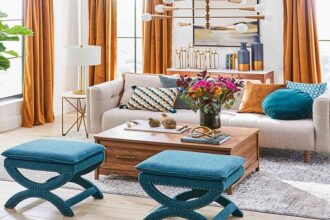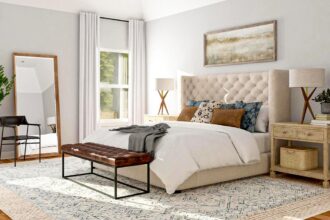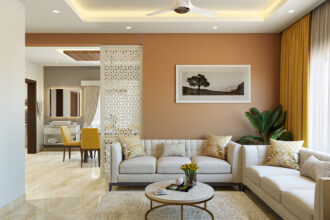Layering is a technique in interior design that adds depth and character to a space. It involves combining colors, textures, and décor elements to create a room that feels inviting and balanced. Below, we’ll guide you on how to layer a room when decorating, providing step-by-step insights to achieve a beautifully designed and cohesive space.
Start with a Base Color
The base color of a room acts as the foundation of your design. This color is often applied to the walls, large furniture pieces, or main area rugs, creating a calm and consistent backdrop. Choosing a neutral color like beige or grey makes it easier to add accents without overwhelming the space. A soft base color also gives you flexibility to add bold or subtle layers on top, resulting in a cohesive look.
Add Depth with Secondary Colors
Secondary colors are used to add depth and dimension to a room. Once your base color is in place, choose one or two complementary colors to enhance the overall theme. For example, if you’ve chosen a neutral base, add secondary colors through throw pillows, smaller furniture, or artwork.
These secondary colors help guide the eye and make the space more visually appealing without clashing with the primary tones.
Incorporate Textures for Interest
Textures add a tactile quality to a room that makes it feel more inviting and interesting. Mixing soft fabrics like velvet or cotton with harder materials like wood or metal creates contrast and depth. Try adding a textured rug, a woven throw blanket, or some linen curtains. Each texture brings its own feel to the space, enhancing the room’s character and making it feel richer and more layered.
Layer in Patterns Carefully
Patterns bring personality and energy to a room when used thoughtfully. Opt for subtle patterns like stripes or florals on items like cushions, rugs, or wallpaper accents. Avoid too many bold patterns, as they can compete with each other. Balancing patterns with solids ensures they don’t overwhelm the space.
By layering in patterns carefully, you’ll add visual interest without making the room feel chaotic.
Vary Heights for Dimension
Varying the heights of furniture, decor pieces, and lighting fixtures can make a room feel more dynamic and well-thought-out. For example, you could place a tall floor lamp next to a lower sofa or stack some decorative items at different heights on a shelf. Changing heights naturally draws the eye around the room, giving it a fuller and more layered look.
Use Lighting to Enhance Layers
Lighting plays a crucial role in highlighting different layers of a room. Start with general overhead lighting, add task lighting for specific areas, and finish with ambient lights, such as lamps or string lights, for warmth.
By using various types of lighting, you can create a cozy atmosphere that enhances each element in the room, making it feel welcoming and complete.
Add Personal Touches for Warmth
Personal touches, like family photos, unique art pieces, or souvenirs, give a room a warm and inviting feel. These items reflect your personality and make the space feel like your own. Displaying a few personal items thoughtfully throughout the room ensures they blend seamlessly with the other layers, adding to the room’s charm without cluttering it.
Finish with Greenery for Freshness
Adding plants to a room is a simple but effective way to bring in a natural element. Greenery not only freshens the air but also adds color and texture. Choose plants that suit the room’s light and space conditions, like large potted plants for corners or small succulents on tables. Greenery enhances the layered look by introducing a refreshing, organic feel to the space.
Conclusion
Layering a room is all about blending colors, textures, patterns, and decor pieces to create a balanced and intentional look. If you’re wondering how to layer a room when decorating, the key is arranging these elements thoughtfully. This approach helps transform any room into a beautifully styled space that reflects your personal taste, making it feel warm, stylish, and inviting.
FAQs
Layering adds depth, warmth, and character to a room, making it feel complete and inviting. It helps balance colors, textures, and decor elements for a cohesive and stylish look.
Neutral tones like beige, grey, or cream are ideal base colors as they allow for flexibility when adding secondary colors, textures, and patterns.
Start with a few contrasting textures, such as a soft rug with a wooden table or a velvet cushion with a linen sofa. Mixing different materials subtly enhances depth without clutter.
Lighting enhances each layer, from base colors to decor items. Combining overhead lighting with task and ambient lights helps create a warm, inviting atmosphere.
Choose plants that fit the room’s size and lighting. Large potted plants work well for corners, while smaller succulents or ferns add freshness to tables and shelves.





